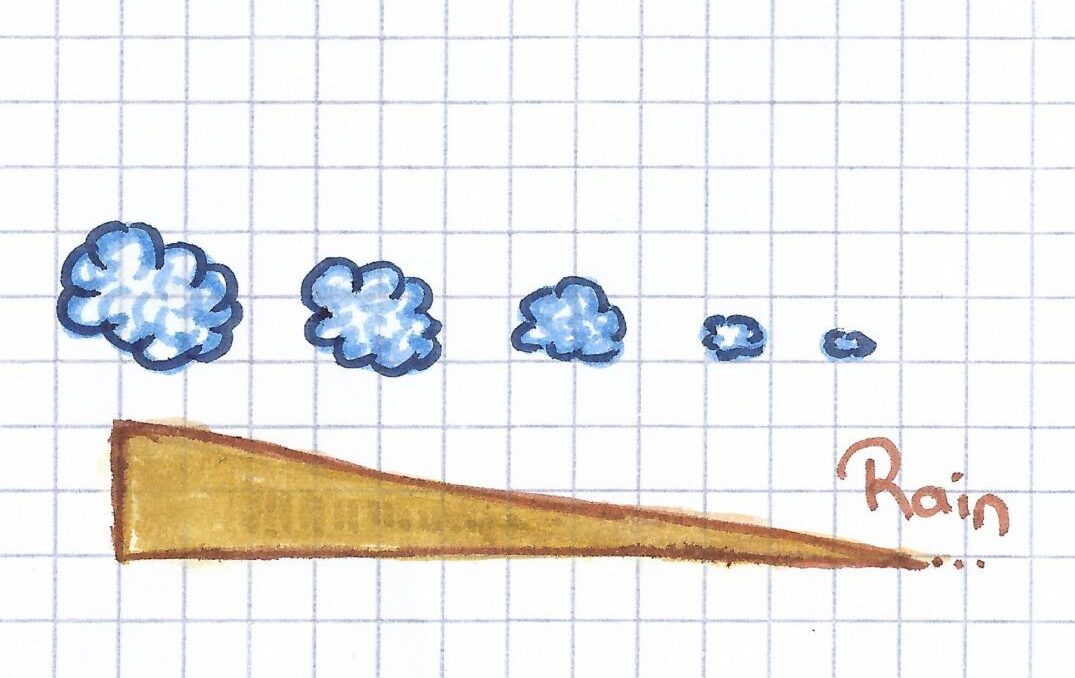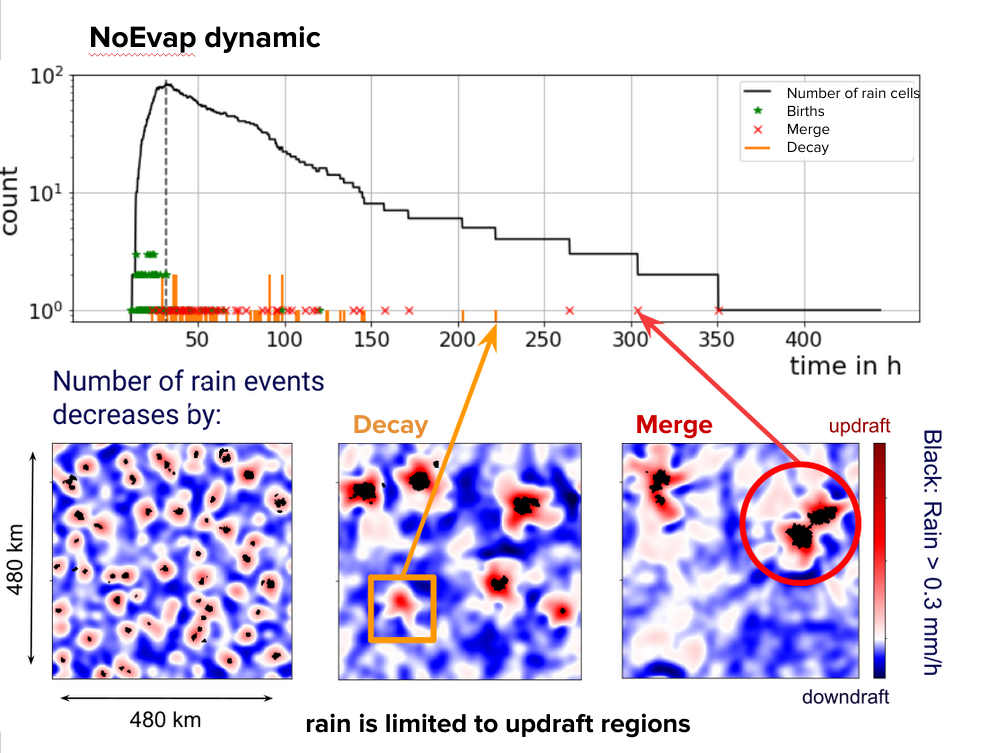
by Ronja Gronemeyer
Merge or die – The fate of clouds and (covid restricted) cocktail parties
How the fate of simulated rain cells improves understanding of tropical storms. Stay tuned, as we learn about rain tracking algorithms and analyze the merging or decaying of competing clouds. Finally, we will see why cold pools affect cloud clustering similarly, as covid restrictions affect a cocktail party…
Welcome back to the tropics. In the first article we learned about cloud dynamics in the tropics, Cold pools and Convective self aggregation (CSA). Again, cold pools form when falling rain re-evaporates in warmer, lower layers. CSA is a phenomenon, which could be linked to the formation of severe tropical storms. Because we lack understanding of the underlying processes, we simulate these clouds in a highly artificial virtual ‘experimental box’. We ask how cold pools influence CSA.
To do so, we start with a clue: We suppress the cold pools we want to study. This allows as to compare dynamics with and without cold pools and is called a ‘mechanism denial experiment’. To remove cold pools from simulation, we enable the re-evaporation of rain. The video ahead visualizes the CSA process and clustering of clouds in the absence of cold pools. We refer to these simulations as the NoEvap case. [ This set up does have value on its own: Tropical storms often develop above the tropical sea, where humidity is high. When humidity is high, the re-evaporation of precipitation is low and only little or no CP form…]. We will compare the NoEvap case from simulations with realistic re-evaporation, which we call FullEvap simulations! Puh, topics of the group ‘climate and complexity’ lives up to its name!
| NoEvap: → Cold pools do form FullEvap: realistic Re-Evaporation → Cold pools are suppressed |
Merging, decaying and the number of rain cells
As fig. aggregation illustrates, proceeding aggregation implies a reduced number of rain cells, thus the number of rain cells can be a measure for aggregation (CSA).

fig. fade: Without noticeable interaction with other rain cells the precipitation of a rain cell decreases
Decaying: Without noticeable interaction with other rain cells the precipitation of a rain cell decreases (fig. fade, fig. aggregation, left: yellow circle)
Merging: Two rain cells move towards each other, overlap and merge to one bigger rain cell (fig. aggregation middle to right)
If you are not interested in any implementation details, feel free to skip this paragraph. But keep in mind: To get an idea of science, understanding how something is measured is equally important as the result itself.
Rain tracking

Abb. aggregation: The number of clouds reduces over the course of the simulation. The size of clouds increases. In the final state of the simulation only one cloud remains, raining at high intensity.
Regen-Tracking
The following video shows how the rain tracking algorithm detects precipitating pixels of the simulation as ‘rain cells’ [Footnote: We define a Rain cell is defined as a dynamical object of a convective updraft, as well as cloud and precipitation]. If two neighboring pixels are actively raining at the same time, we consider them to belong to the same rain cell.
| Tracking Rain cells: First we detect groups of spatially linked actively raining pixels. A pixel is called ‘active’ at a (discrete) simulated time step t, if its precipitation value is above a chosen threshold. Then we link these rain patches over time: Is there any (spatial) overlap of pixels, actively raining at time t and t+1? If so: we assume the rain cell detected at time t continues raining at time t+1.
To define these patches, we use a 4 pixel neighborhood, so for example here at time t all 4 neighbors of the red pixel are above the precipitation threshold. |
Why CPs act on aggregation, as Covid restrictions on a party – Contrasting results of rain tracking for the FullEvap and NoEvap case
Let us start with the FullEvap simulations with cold pools. Cold pools are known to inhibit CSA. Using our party metaphor, we could now imagine a party with Covid 19 restrictions: Everyone at the party has to keep a certain distance, so each person has a radius around them, where no one else can be. Also, people usually leave after less than 2h, so new people can take their spot. Panel a) visualizes, how after the onset of convection, the number of rain cells (black line) is fluctuating around a constant value around 100. The emergence of new rain cells (green) is approximately balanced by the decay (panel b, orange) and merging (red) of rain cells. A decay could be compared to people leaving the party.
Dynamic with Cold Pools: new rain cells ~ merging + decaying
⇒ # of rain cells stays about constant

We assume that merging does not play an important role in the dynamics with cold pools. In simulations with cold pools no aggregation occurred.
But what happens if we remove the cold pools from the simulations and Covid restrictions from the party?
Let us continue with results for the simulation without cold pools. Panel c) shows that as convection starts the number of rain cells in NoEvap is of similar magnitude as in FullEvap. In NoEvap we observe a fast aggregation of convection, which is indicated by a monotonous decrease in the number of rain cells after about one day (panel c, in black). After about two weeks the simulation is fully aggregated and only one rain cell remains. Further we see that after 2 days hardly any new rain cells emerge (green), but since there or no cold pools to disrupt the convection rain cells can last for many days. Clouds just keep raining for days! Again, the number of rain cells is reduced by two processes: decaying (panel d, orange) and merging (red). Fig. NoEvap visualizes these dynamics. Research has shown before that in the absence of CPs simulations always aggregate. And we think merging plays an important role and dominates this special NoEvap aggregation process! Back to the party: Removing Covid Restrictions from the party, allows people to celebrate for days. Their conversations move towards each other and fuse. Everyone keeps dancing actively. Finally all party people gather in one corner of the room and celebrate at maximum intensity. Cloud dynamics can be wild…
What’s behind the statistics? A closer look at the NoEvap dynamic

No Cold pools, no restrictions! Top panel: the NoEvap rain cell statistics (see …). The bottom panel provides insights to dynamics behind these statistics: Areas with surface rainfall above a threshold are plotted black above the convective updrafts (red). Blue marks regions of subsidence or downdraft.
In the left, we see an early stage with many small rain cells. The orange box, marks a decay, A few hours later the convective updraft will have faded too. The red circle marks a merge. The two merging rain cells were already present in the middle, but now moved towards each other and merge to one bigger rain cells. Their raining patches just connected here! Merging does not only reduce the number of rain cells, but also localizes convection. Usually the rain cell resulting from a merge is larger.
Merge or die! Two possible fates for a NoEvap rain cell
On the way to aggregation, a rain cell either merges with other rain cells and becomes part of the final big raincell, or it decays. Enabling cold pools acts as covid restrictions to a party: it prevents (cloud) cuddling, clustering and the fun of aggregation. Hopefully this improved understanding of the NoEvap case, will benefit future research on the formation of convective storms.
For sure, understanding clouds in our highly artificial simulated experimental box is only the beginning. It has some similarity to investigating simulated rooms and aerosols as the first step to prognosing the spreading of pandemic. It is crucial to understand the underlying processes and basic principles, but reality is much more complex! More research is needed to understand the formation of tropical storms. The hope is that these insights will help to prevent harm caused by tropical storms in the future. For us today: Let’s hope that no pandemic causes party restrictions in the next years…









Leave a Reply